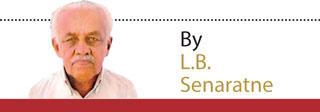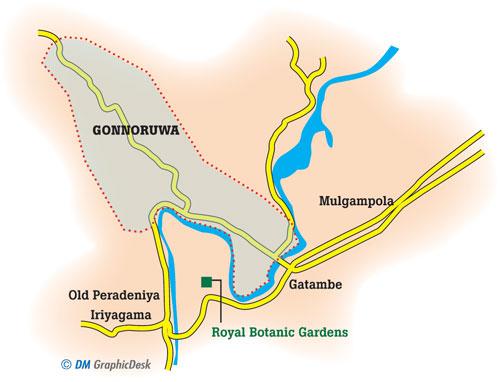03 Apr 2021 - {{hitsCtrl.values.hits}}
 Unsung and unnoticed the last Battle of Gannoruwa, was fought to regain the Kandyan Kingdom from the Portuguese. If the islanders had lost this battle that would have made Ceylon a Portuguese State.
Unsung and unnoticed the last Battle of Gannoruwa, was fought to regain the Kandyan Kingdom from the Portuguese. If the islanders had lost this battle that would have made Ceylon a Portuguese State.
The battle was fought on March 28, 1638 (‘Palm Sunday ‘) which by a coincidence fell on the same day in 2021. The 28-year-old Rajasinghe II maneuvered to retain the Kandyan Kingdom for its people.
|
King Rajasinghe II who led the Sinhalese at ‘the Battle of Gannoruwa’. |
Emerson Tennant in his book on Ceylon describes the Portuguese as “There is no page in European Colonialism more gloomy and repulsive than the period of the Portuguese in Ceylon “
King Rajasinghe 11 did not have a conventional army as in the present day, but every citizen was armed with weapons in their homes; as in the neutral State of Switzerland. It could be knives or artillery, but they had their arms in their homes and the call of the King, their sovereign, could arm them to protect their country and that was Ceylon then.
King Rajasinghe 11 was proclaimed as the king of the Kandyan Kingdom after the death of his father King Senerat, who was married to Wimaldharamasuriya’s wife Dona Catherina and also to the two daughters to gain the Kandyan Throne. King Rajasinghe II also had his brothers Vijayapala and Kumarasignhe. The King had a background of matters of the state having being educated by Franciscan monks; most of them were living in Kandy. With this background he took over the office of state and thought of only peace in his Kingdom.
But the Portuguese, who took over the coastal belt from the Dutch, had other ideas and were hellbent on taking over the Kandyan Kingdom from this young King. After having taken over the coastal belt from the Dutch, the Portuguese were eyeing the kingdom.
 The Portuguese brought in a treaty signed by the late King Senerat and they could negotiate for trade. The Kandyan Kingdom had potential for goods including gems for trade which the Portuguese and Dutch knew, but he ignored the Portuguese signed Treaty and instead signed one with the Dutch in 1638. This Treaty was equally bad for Rajasinghe II.
The Portuguese brought in a treaty signed by the late King Senerat and they could negotiate for trade. The Kandyan Kingdom had potential for goods including gems for trade which the Portuguese and Dutch knew, but he ignored the Portuguese signed Treaty and instead signed one with the Dutch in 1638. This Treaty was equally bad for Rajasinghe II.
With this thought existing the Portuguese realised that it was no easy task. The young King, who did not want a war with the Portuguese, send a friar to work out a plan for peace and trade. The Portuguese ridiculed him and he, in turn, reported to the King.
In the meantime the Dissava of Uva Maharala Rambukwelle Janawallaba was murdered, allegedly by the Portugues forces, who grabbed the King’s attention and decided to protect the Kingdom and the people.
By 1619 the Kingdom of Kotte, Sitawaka and Jaffna were under the control of the Portuguese. In 1633 a merciless General Diogo de Mello took command of the Portuguese forces. De Mello saw the potential for trade with the vast amount of resources in the Kandyan Kingdom and was bent on invading the Kandyan territory.
Rajasinghe knew of the ways and means of the Portuguese and he had in his palace friars and also Portuguese retainers. He was not a fool and knew that he could overcome the Portuguese menace. But he was for peace; which had been taught by the Franciscan monks.
On the other hand the Portuguese knew of the relationship between Rajasinghe II and his brother Vijayapala was not congenial, and this together with other matters thought that it is to their advantage to enter Kandy. The brothers were not even on talking terms as a result of the annexation of Matale by Rajasinghe after the death of the prince of Matale.
But it is said that ‘Blood is thicker than water’ and in the hour of need, Vijayapala entered the area of Rajasinghe.
Able-bodied men came forward to protect their territory and thereby could save the Kingdom. There was loyalty to the Kandyan monarch as he kept the people alive with food and saw to it that they produced and harvested paddy lands.
So De Mello on March 16, 1638 with 900 Portuguese soldiers and 5000 mercenaries camped in their stockade at Menikkadarwara. The command was given to De Mello’s nephew Fernaoa de Mandona Furtaado, a trusted man from the family.
When the King knew of the invasion he made a tactical move and entered into Gale Nuwara. Before that move he had packed off the valuables and state records, which he thought was fundamental. He was determined to route the Portuguese as he knew that these intruders could not defeat a guerrilla force.
On the route to the point of entry the commander knew that they could easily go forward to the kingdom, and passing through places like Danture, Walagama and Dehideniya they arrived at Gannoruwa and then into the inner city of the Kandyan Kingdom. They found an empty city. They rampaged the city and destroyed whatever they came across.
But historians maintain that the real battle commenced on March 27 and by the morning of March 28 the Portuguese tried to retreat to Balana; the rock fortress. They could not reach Balana, but were massacred by the Kandyan forces and the heads were piled in front of the king. It is said that only Portuguese soldiers were left alive and the King ordered that they should not be killed and released. De Mello’s body was never found, but his sword was and presented by the people to Rajasinghe. Thus ended a Battle with the Kandyan people.
27 Nov 2024 43 minute ago
27 Nov 2024 2 hours ago
26 Nov 2024 26 Nov 2024
26 Nov 2024 26 Nov 2024
26 Nov 2024 26 Nov 2024